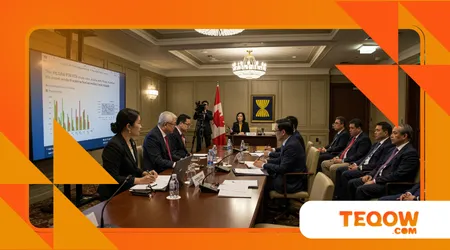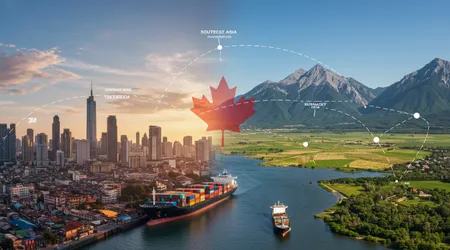Southeast Asia Trade Push

The Southeast Asia Trade Push marks a pivotal moment for Canada’s economic strategy, as Ottawa seeks to diversify trade amid U.S. tariffs ranging from 20–50%.
Foreign Minister Anita Anand’s recent visit to the Indo-Pacific underscores this shift, emphasizing ASEAN’s role in Canada’s future.
With the ASEAN-Canada Free Trade Agreement (FTA) negotiations gaining momentum, Canada aims to deepen ties in energy, food security, digital economy, and AI.
This move isn’t just about trade it’s about resilience, adaptability, and securing Canada’s place in a rapidly evolving global market. Why now?
The answer lies in the turbulent U.S.-Canada trade relationship and the Indo-Pacific’s rising economic clout. This article explores Canada’s bold pivot, its implications, and the opportunities it unlocks.
The Urgency of Diversification: Why Canada’s Southeast Asia Trade Push Matters
Canada’s economy has long leaned heavily on the U.S., with 75% of exports crossing the southern border in 2023.
But President Donald Trump’s tariffs, imposed to curb fentanyl smuggling and re-shore manufacturing, threaten this reliance. Ottawa’s response?
A strategic pivot toward Asia, where ASEAN’s 10 nations Brunei, Cambodia, Indonesia, Laos, Malaysia, Myanmar, Philippines, Singapore, Thailand, and Vietnam represent a $3.8 trillion market.
The Southeast Asia Trade Push is Canada’s bid to reduce vulnerability to U.S. protectionism.
This shift aligns with Canada’s Indo-Pacific Strategy, launched in 2022, which prioritizes trade expansion and supply chain stability.
++ Canada’s Bid to Become an LNG Superpower: Opportunities and Hurdles
The ASEAN-Canada FTA, if finalized, could boost bilateral trade by 20% by 2030, according to government projections.
Canadian businesses, from critical minerals to tech, stand to gain. For instance, a Vancouver-based AI startup recently partnered with a Singaporean firm, showcasing early wins.
Yet, challenges loom. ASEAN’s diverse economies mean complex negotiations, and Canada must compete with China’s regional influence.
Still, the Southeast Asia Trade Push is a calculated move to future-proof Canada’s economy. Can Ottawa balance speed with substance in these talks?

Beyond Tariffs: Building Resilience Through the Southeast Asia Trade Push
The U.S. tariffs, hitting Canadian steel (50%) and autos (25%), have sparked urgency in Ottawa. But the Southeast Asia Trade Push isn’t just a reaction it’s a long-term play.
Canada’s trade with ASEAN grew 15% annually from 2015 to 2023, per Statistics Canada. The FTA aims to accelerate this, focusing on sectors like energy and food security.
Consider Alberta’s canola exporters, who face U.S. duties but see ASEAN’s growing middle class as a new market. Similarly, Canada’s expertise in renewable energy aligns with ASEAN’s net-zero goals.
Also read: U.S. Airstrikes in Iran: Canadian Reactions and Security Concerns
Malaysia’s BlackBerry Cybersecurity Centre, backed by Canada, hints at digital economy potential. However, non-tariff barriers, like ASEAN’s varying regulations, could slow progress.
Ottawa’s push reflects a broader truth: diversification isn’t optional it’s survival. The Southeast Asia Trade Push positions Canada to thrive in a multipolar world. But will it deliver before U.S. tariffs bite deeper?
Collaboration in Emerging Sectors: The Southeast Asia Trade Push Goes Beyond Trade
The Southeast Asia Trade Push isn’t just about goods it’s about ideas. Canada and ASEAN are eyeing collaboration in AI, digital economy, and food security.
For example, a Toronto-based agritech firm is piloting AI-driven farming solutions in Vietnam, boosting yields by 30%. Such partnerships align with ASEAN’s Digital Economy Framework Agreement, set for completion by 2025.
Energy security is another focus. Canada’s liquefied natural gas (LNG) could meet Indonesia’s rising demand, reducing reliance on coal.
Read more: Canada Hosts 2025 G7 Leaders’ Summit in Alberta
Meanwhile, the SEED Canada-ASEAN Scholarships foster people-to-people ties, training future leaders. But geopolitical tensions, like China’s South China Sea claims, could complicate cooperation.
This multifaceted approach makes the Southeast Asia Trade Push a model for modern trade deals. It’s like a tapestry each thread (trade, tech, education) strengthens the whole. Will Canada weave it successfully?
The Geopolitical Chessboard: Canada’s Southeast Asia Trade Push in Context
Canada’s Southeast Asia Trade Push unfolds against a backdrop of global trade wars. The U.S. tariffs, ranging from 10% (Singapore) to 49% (Cambodia) on ASEAN, create both risks and opportunities.
Vietnam’s recent U.S. trade deal, lowering tariffs to 20%, shows ASEAN’s willingness to negotiate. Canada must act swiftly to avoid being sidelined.
Ottawa’s simultaneous pursuit of a China-brokered trade deal adds complexity. Prime Minister Mark Carney’s Liberals, elected in April 2025, promised to reduce U.S. dependency.
The ASEAN FTA, supported by Malaysia’s 2025 ASEAN chairmanship, aligns with this vision. Yet, Canada risks overextending itself, with U.S. talks due by July 21.
The Southeast Asia Trade Push is a high-stakes gambit. It’s like navigating a stormy sea Canada must steer carefully to reach safe harbor. How will Ottawa balance these competing priorities?
Opportunities and Challenges: A Closer Look at the Southeast Asia Trade Push
The Southeast Asia Trade Push offers Canada a chance to tap ASEAN’s 670 million consumers. Canadian firms like Bombardier could supply rail systems to Thailand’s growing cities.
But challenges persist. ASEAN’s regulatory patchwork demands patience, and Canada’s limited diplomatic presence full accreditation in all 10 ASEAN nations only by 2025 hampers progress.
| Sector | Opportunity | Challenge |
|---|---|---|
| Energy | LNG exports to Indonesia | Competing with Australia’s supply |
| Digital Economy | AI partnerships in Singapore | Data privacy regulations |
| Food Security | Canola exports to Vietnam | Non-tariff barriers |
Canada’s experience with the CPTPP, which includes four ASEAN nations, offers lessons. Streamlined customs and clear rules boosted trade by 12% since 2018.
The FTA must replicate this. Will Canada’s Southeast Asia Trade Push overcome these hurdles to unlock ASEAN’s potential?
Additional Opportunities in Critical Minerals
The Southeast Asia Trade Push also eyes critical minerals, vital for green tech. Canada’s nickel and cobalt reserves could supply Indonesia’s EV battery industry.
A Quebec-based mining firm recently signed a deal with a Jakarta partner, signaling momentum. However, environmental concerns and local content rules pose risks.
This focus on minerals underscores Canada’s strategic vision. ASEAN’s demand for sustainable supply chains aligns with Canada’s strengths.
Yet, scaling these partnerships requires investment and trust. Can Canada position itself as a reliable supplier in this high-demand sector?
Strengthening Small Businesses Through the FTA
Small and medium enterprises (SMEs) are central to the Southeast Asia Trade Push. Canadian SMEs, like a Halifax-based seafood exporter, are exploring ASEAN’s markets.
The FTA could lower tariffs, making their products competitive. But SMEs lack the resources to navigate ASEAN’s bureaucracy.
Ottawa’s Export Development Canada is stepping up, offering loans and guidance. This support could mirror the CPTPP’s SME success, where Canadian exporters gained 15% market share.
The Southeast Asia Trade Push must prioritize these businesses to maximize impact. Will SMEs seize this opportunity?
The Road Ahead: Sustaining Momentum in the Southeast Asia Trade Push

Canada’s Southeast Asia Trade Push is a bold step, but success hinges on execution. Anand’s commitment to finalize the FTA “as soon as possible” signals urgency.
Posts on X reflect optimism, with users noting ASEAN’s economic potential. But Canada must avoid rushing into a weak deal, as India’s ASEAN FTA review shows.
Public support is crucial. A 2024 Asia Pacific Foundation survey found 68% of Canadians favor deeper Asian ties. Engaging businesses and communities will sustain momentum.
For instance, Vancouver’s ASEAN trade summits have sparked local enthusiasm.
The Southeast Asia Trade Push is Canada’s chance to redefine its global role. It’s a marathon, not a sprint will Ottawa stay the course?
Building Regional Trust
Trust is the bedrock of the Southeast Asia Trade Push. Canada’s consistent multilateralism, as seen in its 1977 ASEAN dialogue partnership, builds credibility.
Joint initiatives, like cybersecurity training in Malaysia, deepen ties. But ASEAN’s neutrality amid U.S.-China tensions demands diplomatic finesse.
Canada’s balanced approach engaging both ASEAN and China sets it apart. This trust could unlock long-term gains, like co-developing AI standards. The Southeast Asia Trade Push thrives on relationships. Will Canada nurture them effectively?
Preparing for Counter-Duties
If U.S. talks falter by July 21, Canada may impose counter-duties. The Southeast Asia Trade Push could cushion this blow.
ASEAN’s growing demand for Canadian goods, like uranium for Thailand’s energy needs, offers alternatives. But retaliatory tariffs risk escalating tensions.
Ottawa’s proactive stance diversifying now shows foresight. The FTA could stabilize Canada’s economy, as seen in Australia’s ASEAN trade growth post-U.S. tariffs. The Southeast Asia Trade Push is a safety net. Will it hold?
Conclusion: Canada’s Southeast Asia Trade Push as a Global Blueprint
The Southeast Asia Trade Push is more than a trade strategy it’s Canada’s bid to thrive in a fragmented world. By prioritizing ASEAN, Ottawa counters U.S. tariffs while tapping a dynamic region.
From canola fields to AI labs, Canadian businesses stand to gain. But challenges regulatory hurdles, geopolitical risks, and tight timelines demand focus.
This pivot reflects a broader truth: in 2025, no nation can rely on a single partner. Canada’s multifaceted approach trade, tech, trust offers a blueprint for others.
As Anand said, “Diversification is our most important economic tool.” The Southeast Asia Trade Push proves it. Will Canada lead the way in this new era of global trade?
Frequently Asked Questions
What is the ASEAN-Canada FTA?
It’s a proposed free trade agreement between Canada and ASEAN’s 10 nations, focusing on trade, energy, digital economy, and AI.
Why is Canada pursuing the Southeast Asia Trade Push?
To diversify trade amid U.S. tariffs (20–50%) and tap ASEAN’s $3.8 trillion market, aligning with Canada’s Indo-Pacific Strategy.
How will SMEs benefit?
Lower tariffs and support from Export Development Canada could boost competitiveness, as seen with a Halifax seafood exporter.
What are the risks?
ASEAN’s regulatory diversity and geopolitical tensions, like China’s regional influence, could complicate negotiations.
When will the FTA be finalized?
No firm timeline exists, but Canada aims for “as soon as possible,” with talks intensifying under Malaysia’s 2025 ASEAN chairmanship.
